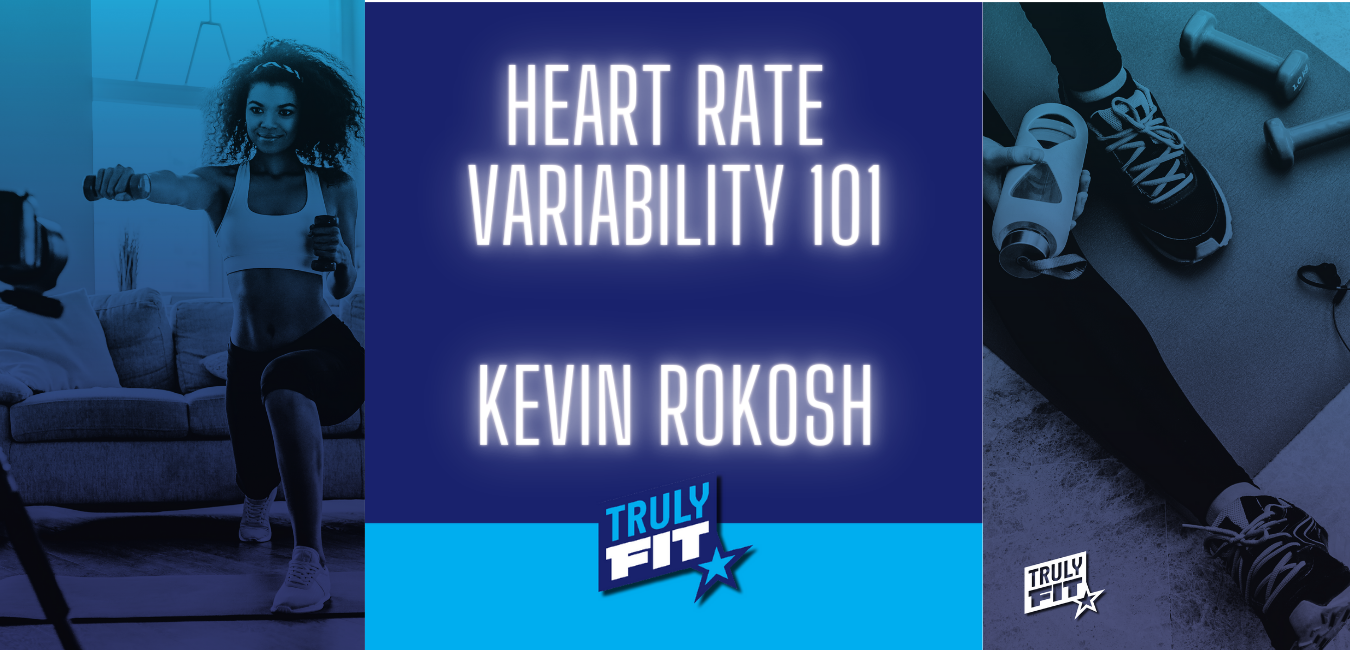
What is HRV? – Kevin Rokosh

Guest: Kevin Rokosh
Podcast Release Date: 4/9/2021
Welcome to Trulyfit the online fitness marketplace connecting pros and clients through unique fitness business software.
Steve Washuta: Welcome to the Trulyfit podcast. I’m your host Steve Washuta, co-founder of Trulyfit and author of Fitness Business 101. On today’s podcast, I’m speaking with Kevin Rokosh about heart rate variability. Kevin is a cycling coach, he has coached riders and racers to discover their epic cycling seasons for 30 plus years.
He has been a road and track racer, he’s ridden this bicycle hundreds of 1000s of kilometers in North America and Europe and loves the cycling lifestyle.
But today specifically, we’re going to talk about heart rate variability. He obviously uses this in accordance with his teaching with his cyclists, and he’s going to explain exactly what heart rate variability is, and then how you go about potentially using that for your clients. You can find all of Kevin’s stuff at epic season coaching.com this was fantastic insight. And with no further ado, here is Kevin.
Thanks for joining the Trulyfit podcast. Can you give the listeners a bio on who you are and what you do?
Kevin Rokosh: I’m a cycling coach that’s based in Edmonton, Canada, so any of the hockey fans out there will be familiar with the NHL Edmonton Oilers. Wayne Gretzky spent most of his career here. Now we’ve got Connor McDavid tearing up the record books. So we’re Western Canada, a little bit further north. Kind of cold still here. I’m a certified cycling coach and a level one coach with training peaks. So I’ve been doing this for a little more than 10 years now.
Steve Washuta: Wow. Yeah, I actually don’t really know many cycling coaches. I know, a lot of cyclists have worked with triathletes, but I don’t know many coaches who work with cycling. And I’m sure you’ll talk about a little bit more exactly what you do. As far as the cycling coaching. And the majority of this conversation is going to be around heart rate variability. But I do have to ask first, is the cycling coaching only physical or is there also a, like an approach to it that is like, I guess you would say like strategic?
Kevin Rokosh: Certainly, we need to plan our workouts, our cycling, and training around the events that might be coming up on the calendar ahead of us. So we do use a lot of what’s called periodized training, where we’re layering in high-intensity workouts, and lower-intensity workouts to bring the athlete to a peak fitness around their, their, their goal event in the training year.
A lot of that is is racers, but you don’t just have to be a racer to be interested in, in hitting a peak performance, you can just be interested in a big granfondo somewhere, a charity ride, that sort of thing.
There’s a strategy there that coaches will put the athletes through with their training.
Steve Washuta: Well, that makes perfect sense. And a good lead-in to our topic today, I’m sure one of those things that you’re looking at when you’re trying to get your racer or your clients or your athlete to their peak performance. One of those measurables is HRV heart rate variability, can you explain exactly what heart rate variability is and give it a definition.
Kevin Rokosh: It’s what you think of: your resting heart rate. You know, it might be 50 or 60 beats a minute, that resting heart rate is not beating like a metronome. So it’s not a steady rhythm. There’ll be a beat-to-beat time difference. So when we’re at rest, then when we start working out, our heart rate elevates and becomes much more regular. But at rest, it’s got this beat that’s different. And it’s that difference that can kind of reflect the state of what we call your autonomic nervous system. So that’s the nervous system inside of us that’s like automatic. It is called automatic autonomic.
There are two sides to this, this nervous system that’s doing these automatic things that for us in the background. There’s the parasympathetic side and the sympathetic side.
The parasympathetic side of the nervous system that’s rest and digest, that’s when we’re relaxed, and with a really high HRV number.
That tells us that that parasympathetic system is taking care of us and and and we’re in our recovery Whereas this empathetic side, the other half, that’s like the gas pedal.
So when we’re working out, that gas pedal is driving our heart rate faster. When the HRV starts getting low when we’re supposed to be relaxed, that to me is that the sympathetic system is still kind of putting some gas on us. We’re not really so much in a good recovered state.
So the HRV is giving us an insight into how recovered we are after we’ve been working out.
Steve Washuta: That’s a great definition. Now, can you use HRV? Give me a scenario. I had a hard workout that Kevin designed for me.
And the next morning, I wake up from that workout, can I look at my HRV and tell things from that angle? Or is this only used immediately post-workout?
Kevin Rokosh: Yeah, no, that’s a good point. It’s something you don’t want to look at immediately after you’ve done a workout. We want to look at it in what’s probably our best resting state, which it would be like first thing in the morning. So I measure my own every morning, right? When I’m waking up, I take a couple of minutes. And there’s a number of apps that are available on our phones, that that can help record the morning HRV.
And so it gives you that insight into how rested You are the next day so that that previous workout the previous day if I’m well recovered, I should see a pretty high HRV number. There’s not a specific HRV number that you’re trying to train for it’s individual to all of us.
But what you need to do is build up a database, of what HRV is, is appropriate for you. So these apps will record it. You’ll want to see, about two weeks’ worth of data that starts to give you a baseline number, and then we can really tell was that workout the day before something that pushed me over the edge or not. So these apps can help guide us to what we should do with the number that we measure in the morning.
But like I said, you want the context of the morning, there are some other devices out there like the Whoop Strap or the Aura Ring, which are great. But they’ll be measuring HRV across the whole day.
If we did look at that HRV right after your workout, it would be really low, because you were stressed out by it. Well, that’s not the context that we’re trying to look at, we really just want to look at the context of when we’re rested, recovered, waking up.
Steve Washuta: But can you personally have a sense of what your HRV is by how you feel? So again, let me give you an example. Can you wake up in the morning, let’s say seven days a week, or close to that, let’s say five to seven days a week, and simply guess, if your HRV is at a good level based upon how you feel or feelings not connected with us?
Kevin Rokosh: So these apps, you will record those feelings. And then over time, you’ll start to learn how those feelings will tend, to coordinate with your HRV. But it still will give you some insight, even though you might feel great to go, you might have a really low number. And it might also be an indication of something else that might be brewing in the background that you’re not aware of. If you are coming down the cold, perhaps, trending lower HRV might be indicative of that.
There were I believe some studies, that I’m not sure what the results are, but they were trying to look at an HRV as a predictor for somebody coming down with COVID as well. But like I said, I don’t know what the results of those were, how accurate that would be. But you will have a sense of perhaps how I might be feeling today. And guess what, you might have a low HRV but it’s still it’s a good objective measure. I tell my athletes when a coach is not there right with you and in these virtual training days.
We’re all going through a lot of that. When a coach is there to look at the bags in your eyes. For my cyclists that you’re pedaling squares, the HRV can really give that objective feel feedback of how you’re truly doing. And then you can share the actual HRV results with your coach and they will then help guide you as well to do what maybe you should do that day.
Steve Washuta: Yeah, so that leads into my next question. I’m going to set this up by talking about Henry Cejudo, who is an Olympic wrestling champion at a two-time two different weight class UFC mixed martial arts champion, I know that he used HRV. By him, I mean, his coaches to set up his workout.
His workouts were never pre-determined, they woke up, they looked at his HRV in the morning, and then they responded accordingly, is this the norm for using HRV? Is this just how you use it with your clients too?
Kevin Rokosh: This is certainly one of probably the strongest ways to use HRV. So if you’ve got the time and effort to work with an athlete, that would be the ideal way you would look at their morning HRV. And you would prescribe the workout for them that day, based on their HRV, you might not you know, if they have a low number, you might not that first day you see the low number make a big change to their training plan. But if you see like two days in a row that’s for sure a red flag. Now we’ve got to pull this athlete back from their high-intensity training.
So it might then be a rest day or a very low-intensity training day. So certainly, it’s something when you’re really working one on one to close with an athlete that you can use that way. But also, if you’ve got somebody on a bit of more of a predetermined training point, you can just let them run with that training plan.
But again, if they see a low HRV number, then maybe that day, if there were pre-scheduled intervals to do, the coach just gives them that guidance that when you see a low HRV number, take an easy day with the training.
Steve Washuta: That’s great information, and just how my mind works, I best understand an example. So I’m starting to work with an athlete of some sort. Maybe for the first two weeks during our training, I have him or her or myself simply record their HRV every morning. Then after those two weeks, because I have a baseline, or somewhat of a baseline, understanding of what their personal HRV is, now I’m ready to potentially prescribe my workouts based on what their HRV is moving forward into the next weeks.
Kevin Rokosh: Excellent. Yes, that’s would be an ideal setup to start working with it.
Steve Washuta: Okay, well, that’s good to know. So do you think that HRV is maybe, I hope I don’t misuse the proper term, but misused, because I can tell you that as a national Academy of Sports Medicine, certified personal trainer, you know, we brushed up on this, it’s touched on but we don’t use it in our day to day training?
Kevin Rokosh: Finally, technology has caught up with science. So we have devices that give us the fidelity in the heart rate measurements to actually measure HRV because it’s really subtle, It’s actually it’s not just as a simple average of the heart rate difference, there’s some statistical data that’s being done with that.
Not all heart rate monitors actually report the data, in the best method to extract the information from it.
So there are a couple of straps like the Wahoo Ticker, Heart Rate Strap, the Polar H 10 Heart Rate strap, those ones do have the right fidelity in the heart rate information for these apps to extract the heart rate variability data from it.
I think it’s just been right now it’s a matter of finally, we’ve got the technology that’s caught up and available in the hands of our everyday athletes.
We don’t have to hook them up to ECGs to measure HRV and so it’s really put it in the realm that we can use it every day with our athletes.
Steve Washuta: Is it a misguided thought that the HRV monitors or I should say just these overall like sort of heart rate monitors that go around your chest and then have a watch or some sort of device that that connects with that are better than your you know, then than just the watch without that?
Kevin Rokosh: Yep, potentially better? Yes, because we get a better electrical conductivity between our skin and our chest drops to measure heart rate there. An Apple Watch, for example, though, will also extract HRV data from the measurements it’s making, but the optical sensors on your wrist are not quite as sensitive as your chest straps. So I still prefer to use a chest strap to extract the data. For instance, like when I measured on myself in the morning, I don’t sleep with my chest strap on. Just when I wake up at that moment I put on the chest strap briefly to take my measurement.
Steve Washuta: Yeah, that makes sense. There’s one, I think you just mentioned it before: that actually goes around your, your ring finger. Is that correct?
Kevin Rokosh: That’s right, yeah, that one’s called the Aura Ring. It’s got the optical sensors on the inside of the ring that goes on your finger. There are some apps out there that will read an interface with that data that looks separate from the auras app, like HRV for training is one of the apps, that’s actually the one that I use. It can extract the data from, like I say, the right timeframe, because you want the data, just use the data when you’re waking up. Then so your training app can pull the data just from that time frame when you’re waking up to make the reading.
Steve Washuta: Are there any other subtle nuances or tips and tricks that you would try to relate to somebody who’s a first time user of whether it’s the looking at heart rate variability, or whether it’s the tools to use to find out what it is,
Kevin Rokosh: When you’re taking the measurement, one of the things you have to avoid is swallowing. So the swallow reflex can actually make your heart rate almost look like what we call attack cardio, it’ll make a little bit of a bump in the heart rate, which can mess up the measurement.
So when you’re taking the measurement, you want to be relaxed, I typically will take my measurements sitting up in bed, just because there’s just that little bit of “Oh, I’m not exercising”, but there’s just a little bit of motion, that I add to my resting heart rate just to see just to perturb it a little bit, give it a bit of a nudge and just see how well it responds.
I’ll sit up in bed, wait a minute, wait for it to settle back down a little bit, and then take the HRV reading at that point. That’s one of my tips. The other thing that can interfere with it is if you’re waking up and you got to go to the bathroom, the stress of having to empty that bladder will influence your HRV. So take a moment and go to the bathroom, you come back, relax for another maybe five minutes, then take the measurement.
Steve Washuta: That’s fantastic information. And you know, I mean, having not known that most people probably have to go to the bathroom upon waking up.
So it’s good to know that it’s best to get that first part done before we measure our HRV. Right? So I know you touched on it briefly before and then we didn’t get into specifics, but I’m gonna have to bug you on this a little bit just because I’m so naive to this. Can you give me just an average number and tell me about your numbers? Can you tell me a little bit about super low or super high and anything in that number’s room to pass on?
Kevin Rokosh: Actually, not really, because most of these apps will take the raw number and then turn it into a one to 10 ratings our one to 12 or something like that, I think the app that I use: HRV for training, puts it into a one to 12 ratings. So most days, my rating will be a 10 to 11 and a half. But for instance this morning it came in and for some reason that seven and a half. That was out of my normal range. My app was basically telling me: “maybe today you should think about cutting back on your intensity”.
Steve Washuta: Just to make sure, one being the low 12 being the high? Yes? That’s really interesting that they go about it that way. Do you know why they do that? Do you think Is it because it’s just too esoteric and complex, whatever they’re trying to measure or this is just how it’s measured in every realm?
Kevin Rokosh: No, it’s probably just so they can put it into a number that we can comprehend a bit better. I think the raw number for me was like my raw number range is 257 thing in its root mean square time difference between beats. It is a number that it’s starting to lose meaning if you’re a science and math geek. So putting it down into a one to 12 reading makes it much, much easier for us to just comprehend what that means.
Steve Washuta: Yeah, that makes perfect sense. Like you said, Now that the technology is catching up, just your average Jimmy and Joe can go out there and grab one of these things. Look it’s important that the spell it out in kind of layman’s terms, so that we’re not trying to do some complicated math equation to measure that HRV. Can you tell us which band or watch or app or ring that you specifically use?
Kevin Rokosh: I have mentioned a couple times already, the one that I use is called HRV 4 Training. That is the letters HRV, the number four, and then training that’s available in the Apple App Store and Google Play.
That is one does have clinical trials that they’ve done that, validate, its readings, as well as a couple of other apps out there, I haven’t used these ones, but the other ones that, are also validated and folks can look for one is called I-fleet that so that’s i, t h, l, e, t. So like an athlete, but spelled with an eye instead of an A, and then the other one is elite HRV.
All three of those apps will automatically measure for you or they’ll interface to the aura ring or the Apple Watch. The other thing that HRV 4 training will do is it will actually turn your cell phone’s camera into a little heart rate monitor, so it can take the reading by putting your finger over the camera, and then the app turns on the LED flashlight on your camera as well.
Like what you think that If anybody out there is familiar with a pulse oximeter is kind of like turning your camera into a pulse oximeter on your finger, and it has HRV for training anyways has been validated to use that to measure your HRV in the morning.
Steve Washuta: Well, Kevin, this has been super informative. Thank you so much for all this information, can you tell the listeners where they can find out more about you? And whether it’s your cycle coaching or anything else that you do? Then if listeners want, they can reach out to you specifically with any questions,
Kevin Rokosh: Sure, they can all reach me at my website is probably the best place to reach me. And that’s epicseasoncoaching.com.
I’ve got actually there a number of coaching programs, but something that some of your athletes out there listening might be interested in is I have an academy of Epic-Season Academy. I’ve created a discount code for your members out there: Trulyfit all in caps. They can get a membership in my Epic-Season Academy for $30 a month.
While they’re on my website, I’ve also got a special report called “three steps to envision your epic season”. So all of our athletes out there should have a good plan, no plan is a plan to fail. That’s a free report that they can pick up of my website so that again, my website is epicseasoncoaching.com.
Steve Washuta: Well, that’s great. Thank you for that. I can tell the listeners here that I’ve been on the website and Kevin is super thorough, and it’s a great program. So check it out! Kevin, thank you so much and hopefully we will speak on a future podcast about a different topic.
Kevin Rokosh : Absolutely. Steve, it’s been great talking with you.
Steve Washuta: Thanks for joining us on the Trulyfit podcast. Please subscribe, rate, and review on your listening platform. Feel free to email us as we’d love to hear from you.
Thanks again!
CLICK FOR AUDIO OF PODCAST





